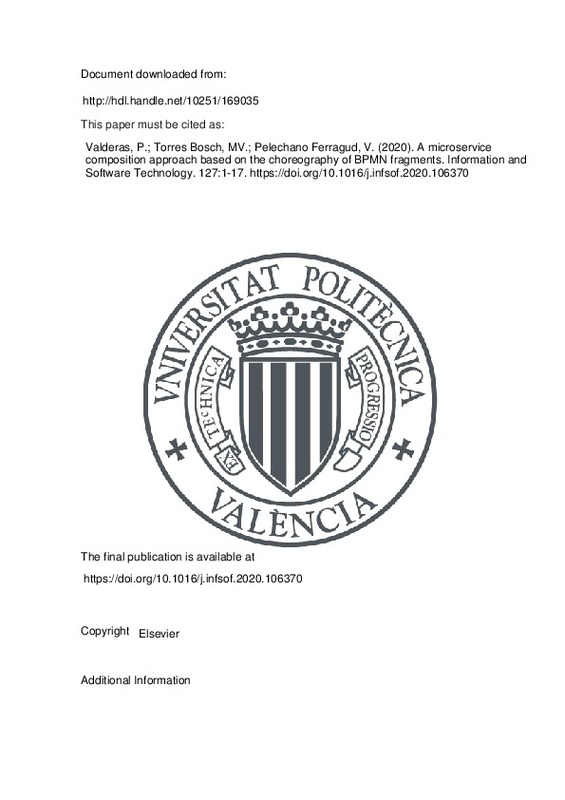Azkaban. (2019). Open-source Workflow Manager. URL: https://azkaban.github.io/. Last time accessed: November 2019.
Basu, S., Bultan, T., & Ouederni, M. (2012). Deciding choreography realizability. ACM SIGPLAN Notices, 47(1), 191-202. doi:10.1145/2103621.2103680
Basili, V. R., & Rombach, H. D. (1988). The TAME project: towards improvement-oriented software environments. IEEE Transactions on Software Engineering, 14(6), 758-773. doi:10.1109/32.6156
[+]
Azkaban. (2019). Open-source Workflow Manager. URL: https://azkaban.github.io/. Last time accessed: November 2019.
Basu, S., Bultan, T., & Ouederni, M. (2012). Deciding choreography realizability. ACM SIGPLAN Notices, 47(1), 191-202. doi:10.1145/2103621.2103680
Basili, V. R., & Rombach, H. D. (1988). The TAME project: towards improvement-oriented software environments. IEEE Transactions on Software Engineering, 14(6), 758-773. doi:10.1109/32.6156
Bocciarelli, P., & D’Ambrogio, A. (2013). A model-driven method for enacting the design-time QoS analysis of business processes. Software & Systems Modeling, 13(2), 573-598. doi:10.1007/s10270-013-0345-5
BPMN. (2011). Business Process Model and Notation (BPMN). Version 2.0. Object Management Group. URL: https://www.omg.org/spec/BPMN/2.0/PDF/. Last time accessed: April 2020.
Carbone, M., & Montesi, F. (2013). Deadlock-freedom-by-design. ACM SIGPLAN Notices, 48(1), 263-274. doi:10.1145/2480359.2429101
Chandramouli, R. (2019). Security Strategies for Microservices-based Application Systems (No. Special Publication (NIST SP)-800-204).
Chor. (2014). Choreography Programming Language. URL: http://www.chor-lang.org/. Last time accessed: November 2019.
Fowler, M. & Lewis, J. (2014). Microservices. ThoughtWorks.
Fowler, M. (2015). Microservices trade-offs. URL: http://martinfowler.com/articles/microservice-trade-offs.htm. Last time accessed: July 2019.
Gabbrielli, M., Giallorenzo, S., Lanese, I., & Zingaro, S. P. (2018). A Language-Based Approach for Interoperability of IoT Platforms.
ING Baker. (2019). Orchestrate Microservice-Based Process Flows. URL: https://github.com/ing-bank/baker. Last time accessed: November 2019.
Leopold, H., Mendling, J., & Gunther, O. (2016). Learning from Quality Issues of BPMN Models from Industry. IEEE Software, 33(4), 26-33. doi:10.1109/ms.2015.81
March, S. T., & Smith, G. F. (1995). Design and natural science research on information technology. Decision Support Systems, 15(4), 251-266. doi:10.1016/0167-9236(94)00041-2
Netflix Conductor. (2019). A Workflow Orchestration Engine that Runs in the Cloud. URL: https://netflix.github.io/conductor/. Last time accessed: November 2019.
Nie, H., Lu, X., & Duan, H. (2014). Supporting BPMN choreography with system integration artefacts for enterprise process collaboration. Enterprise Information Systems, 8(4), 512-529. doi:10.1080/17517575.2014.880131
Nikaj, A., Weske, M., & Mendling, J. (2018). Semi-automatic derivation of RESTful choreographies from business process choreographies. Software & Systems Modeling, 18(2), 1195-1208. doi:10.1007/s10270-017-0653-2
Peltz, C. (2003). Web services orchestration and choreography. Computer, 36(10), 46-52. doi:10.1109/mc.2003.1236471
Pininterest Pinball. (2019) A Scalable Workflow Manager. URL: https://github.com/pinterest/pinball. Last time accessed: November 2019.
Preda, M.D., Gabbrielli, M., Giallorenzo, S., Lanese, I., & Mauro, J. (2016). Dynamic Choreographies: Theory and Implementation. arXiv preprint arXiv:1611.09067.
Terraform. (2019). URL: https://www.terraform.io/. Last time accesed: July 2019.
Uber Cadence. (2019). Fault-Oblivious Stateful Code Platform. URL: https://cadenceworkflow.io/. Last time accessed: November 2019.
Vaishnavi, V., Kuechler, W., and Petter, S. (Eds.) (2004). “Design Science Research in Information Systems” January 20, 2004 (created in 2004 and updated until 2015 by Vaishnavi, V. and Kuechler, W.); last updated (by Vaishnavi, V. and Petter, S.), December 20, 2017. URL: http://desrist.org/desrist/content/design-science-research-in-information-systems.pdf. Last time accessed: July 2019.
Weber, B., Reichert, M., & Rinderle-Ma, S. (2008). Change patterns and change support features – Enhancing flexibility in process-aware information systems. Data & Knowledge Engineering, 66(3), 438-466. doi:10.1016/j.datak.2008.05.001
Zeebe. (2019). A Workflow Engine for Microservices Orchestration. URL: https://zeebe.io/. Last time accessed: November 2019.
Zhang, H., Babar, M. A., & Tell, P. (2011). Identifying relevant studies in software engineering. Information and Software Technology, 53(6), 625-637. doi:10.1016/j.infsof.2010.12.010
[-]







![[Cerrado]](/themes/UPV/images/candado.png)


